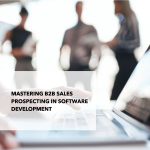How to Build a Go-To-Market Strategy for Your SaaS Product
Follow these steps to develop a GTM strategy that will help you achieve product/market fit faster.
In many businesses, there’s a tremendous enthusiasm for game-changing software, with the expectation that customers will flock to invest, causing explosive growth overnight. However, we have seen that even the most innovative SaaS products rarely scale overnight.
Go-to-Market Strategy
There are thousands of SaaS products offering various services in today’s tech landscape, and competition is inevitable. As a new product on the market, you need a strategy to break in effectively. Your software, no matter how great, needs to be marketed and sold at a reasonable price for your market, and the launch process must be smooth to achieve product/market fit.
Below is a guide to help you get your SaaS product up, running, and sold to businesses as quickly as possible.
Identify Your Audience
“Who needs your product?” is a fundamental question to ask even before developing your product. Knowing your target audience helps you understand who would benefit from your product and what problems it solves.
- Target Audience: Determine who your potential buyers are to tailor your sales approach.
- Value Proposition: Understand why they would want to buy your product. Identify the problems you solve or the benefits you bring.
Most businesses now expect to trial your software for free, requiring you to provide a limited version of your product that customers can test.
- Full Trial: Offer every feature for a limited duration to potential high-value customers.
- Stripped-Down Version: Provide a basic version for free, allowing smaller customers to explore your product independently before opting for a paid version.
Gather feedback from both trials and paying customers to adjust your product and marketing strategies accordingly.
Understand Your Customers
Your sales team needs clear direction on which customers to approach. Decide whether to target small businesses, mid-level businesses, or large corporations, each having different needs and sales cycles.
- Small Businesses: Quicker decision-making but smaller purchases.
- Large Corporations: Longer sales cycles but larger contracts.
Highlight Product Benefits
Clearly articulate the problems your product solves and its benefits. Explain to potential customers:
- Pain Points: The specific problems you fix.
- Value: The unique functionalities your product offers.
- Impact: The tangible results your product delivers.
Marketing and Sales Strategy
A strong marketing and sales strategy is crucial for success. Build your brand to align with your target customers, decide on marketing channels, and develop an effective sales funnel.
- Branding: Align your brand with the customers you want to attract.
- Marketing Channels: Use organic traffic, paid advertising, cold calling, and referrals.
- Sales Funnels: Simplify the signup process and have a strategy for following up with trial users.
Pricing Strategy
Decide on a pricing model that fits your target market:
- Monthly Set Fee: Unlimited use within SLA.
- Tiered Pricing: Different features at different price points.
- Licensed Users: Per-user licenses.
Launch Strategy
Avoid the “one more feature” trap. Launch a Minimum Viable Product (MVP) to get market validation before adding more features. Early feedback will help you refine your product and achieve product/market fit faster.
Looking to Launch or Expand?
While many of these steps may seem basic, they are essential for launching a new SaaS product. At nGülam, we work with SaaS companies worldwide to help them achieve maximum value. If you’re planning to launch a new product or expand into additional markets, we can help you set up a top-notch strategy to get your software into the hands of those who need it most.







